
| BMW Garage | BMW Meets | Register | Today's Posts | Search |
 |
|
|
 SUPPORT ZPOST BY DOING YOUR TIRERACK SHOPPING FROM THIS BANNER, THANKS! |
|||||||||
Post Reply |
|
|
Thread Tools | Search this Thread |
| 11-01-2013, 03:26 PM | #1 |
|
Lieutenant Colonel
 948
Rep 1,910
Posts |
A Z4 Tour of Virginia Plantations, Here and Gone
Based on my usual lack of good judgment, I set off to tour Tidewater Virginia in the midst of Tropical Storm Karen’s pouring rain and the recent government shutdown. I got plenty wet, and—for the first time ever—the Z4’s top remained in place throughout the tour, but I had a super time. Even though the main goal of my tour, namely the Jamestown Settlement, was closed.
It didn’t start raining immediately, but even a novice meteorologist could read these skies and know what was coming. The wind-blown woman in the distance could read them, too, and she was out checking on plants and battening down the hatches. My friend Nevin, incidentally, tells me that these are soybean plants. 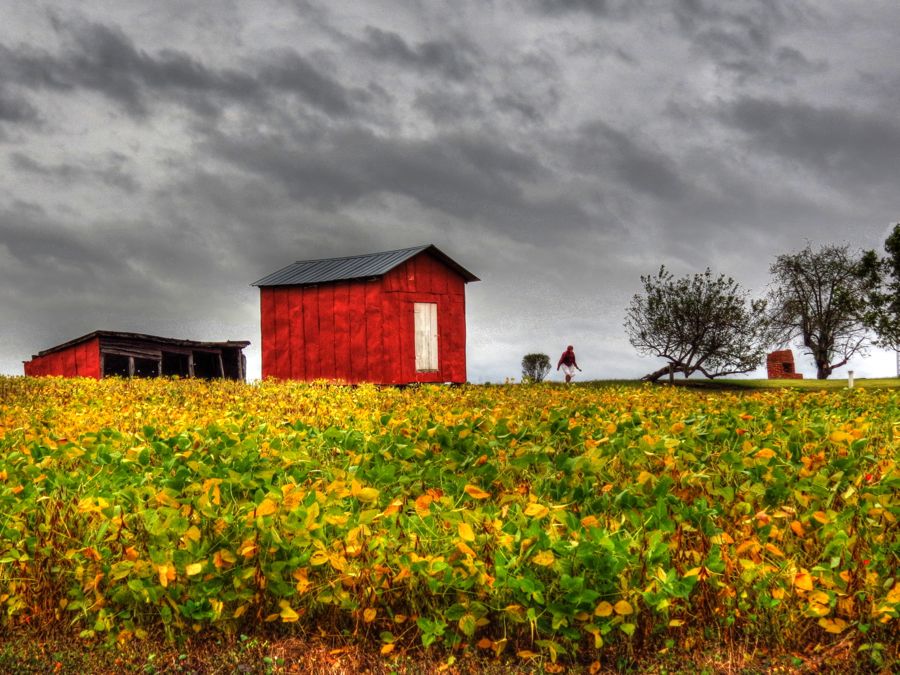 Although it was only October 9, there were already some signs of Fall Colors.  There’s not a whole lot left of Central Point, Virginia, other than a church, some houses, and this store-like building. As I so often discover after the fact, however, Central Point played an important role in history. Specifically, it was the home of Richard and Mildred Loving, a young couple who grew up here and married in 1958. Later that year, they were arrested in their bedroom in the middle of the night for the “crime” of interracial marriage, with Richard being white and Mildred black, and they were forced by law to leave Virginia. Their case, Loving vs. Virginia, eventually reached the Supreme Court in 1967, which struck down all U.S. laws against interracial marriage. The couple returned to Central Point and lived out the rest of their lives here.  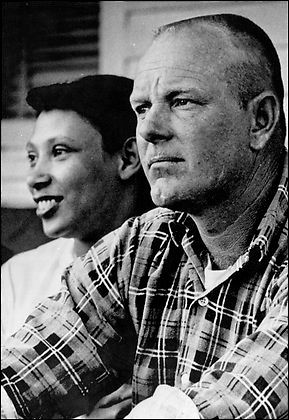 Throughout the trip, I discovered many other farms and communities in this area that seemed to be petering out.   In contrast, Newtown, VA seemed to be doing fine. Newtown is located at the intersection of two very old Indian trails, one of which eventually became the Great Post Road from Williamsburg, VA to Philadelphia, PA. Newtown was settled in 1769 and by the 1840s had become the largest town in King and Queen County. This home was built by Samuel Gresham in 1845 and served for many years as the post office…  …while this one was once Walton’s Academy, known originally as the Newtown Female Institute. The Rev. E. Payson Walton built it in 1853 to serve as his home and boarding school.  I discovered this beautiful blonde across the road. Whilst composing a second photo, suddenly my viewfinder was filled with a beautiful brown eye and a determined look that seemed to say “Feed me!” I dutifully fetched all the tall grass I could find on my side of the electrified fence and (gingerly) handed it over to said blonde.   Although I needed gas, I decided not to get any here. Could be a little stale, don’tcha know…  I had forgotten that almost every other church in this part of Virginia is of the Baptist persuasion. With thoughts of Kim and Cathy ever in mind, I found and photographed the 1871 Bethlehem Baptist Church, the 1851 Bruington Baptist Church, the Zion Baptist Church, and the ruins of the 1775 Exol Baptist Church. The last of these, incidentally, was built by one John Waller, who was described as follows in an 1859 biography: “Giving loose to every species of wickedness and profanity, he quickly acquired for himself the infamous appellation of Swearing Jack Waller.” Over time, however, he found religion and changed his evil ways (or many of them, it seems). He served as the pastor for Exol Baptist from 1775 through 1793.     All of these fine institutions paled compared to the historic Mattaponi Church, which was built in about 1730. It began as an Anglican (Church of England) house of worship but was abandoned following the American Revolution. The Church of England had been the sole authorized (and State-supported) church in Virginia, but it was officially “disestablished” in 1786. An enterprising group of Baptists took over the Mattaponi Church for their use in 1803, and it has continued as a Baptist church ever since.  Court activities have taken place at the King and Queen Courthouse Green for 322 years. My favorite spot was the old jail, which dates back to at least 1828. It was burned by Union troops in 1864 (along with the rest of the courthouse complex) but was promptly rebuilt. There used to be a sycamore tree next to the jail; the last public hanging in the county took place from one of its branches.  The Fary Tavern has stood next to the courthouse since 1802, serving as a hotel until being sold to the county in 1941.  Everyone has heard of West Point in New York, but how many of you know of West Point, Virginia? (I didn’t, prior to this trip.) West Point is a tenacious little strip of land lying between the Mattaponi and Pamunkey Rivers, which join here to form the mighty York River. In this aerial photo, the Mattaponi is on the left and the Pamunkey on the right. Note that the town is only about 3 blocks wide and surrounded by rivers—and thus prone to severe flooding.  This photo was taken from the very end of West Point, looking out at the newly formed York River. As the rain continued to pour down, I began to question the wisdom of visiting a place subject to severe flooding!  Pretty much any place you choose to park in West Point is guaranteed to be scenic.  Did you notice the railroad yard in the aerial photo? I was determined to get a look at it. I first tried to get there from the far end of the road in this photo. Before long, I realized that my faithful Z4 was producing a monumental bow wave through the flooded street! As I made a hasty u-turn, I tried to remember where the air intake is on the BMW. High? Low (as on my old 1987 Porsche 944)? Fortunately, it was high. If I’d been in the 944, the engine would have sucked water right into the intake, through the manifold, and into the cylinders, where it would not have been compressed by the pistons… The result would have been one or more bent connecting rods of the expensive German variety! Fortunately, the Z4 escaped unscathed. There’s probably a lesson here…  With a little rerouting, I made it to the position shown in the photo above, safely on the north side of the flooded road. But maybe not all that safely; to my right was this view… 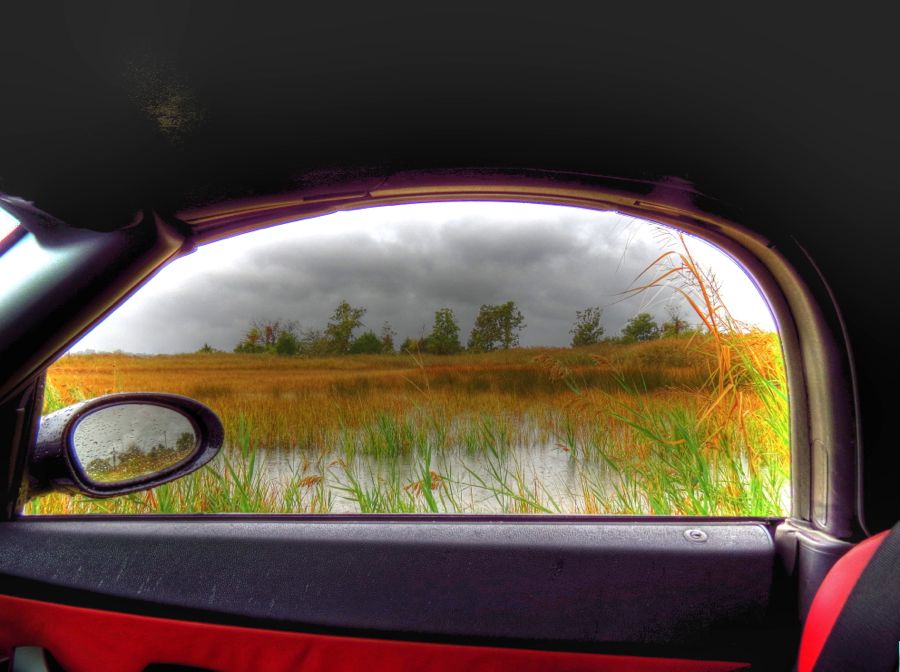 …while this scene greeted me out the driver’s-side window. I chose to move on toward the railroad yard.  Back in the day, the Richmond and York River Railroad brought tobacco and other products to the port at West Point. The line was heavily damaged during the Civil War, but it survives today as part of the Norfolk Southern Railroad. On this rainy day, the graffiti’d rail cars stood out, as did the foliage—and the continually encroaching water.   As I left West Point in the steady downpour, I was grateful to soon find myself on Ark Road… The Walter Reed Medical Center in Washington, DC is well known for its treatment of soldiers, members of Congress, and the occasional U.S. President. But who was Walter Reed? Major Walter Reed, M.D., served as an Army physician. He led the research effort that conclusively determined in 1901 that yellow fever is transmitted by mosquitoes. The team’s efforts were of great importance: In 1793, for example, nearly 10 percent of Philadelphia’s population had died from this disease. Major Reed was born in this unprepossessing house in Belroi, VA in 1851. Sadly, he suffered a ruptured appendix in 1902 and died of peritonitis at the U.S. Army Medical Treatment Facility—which was later named the Walter Reed Medical Center. 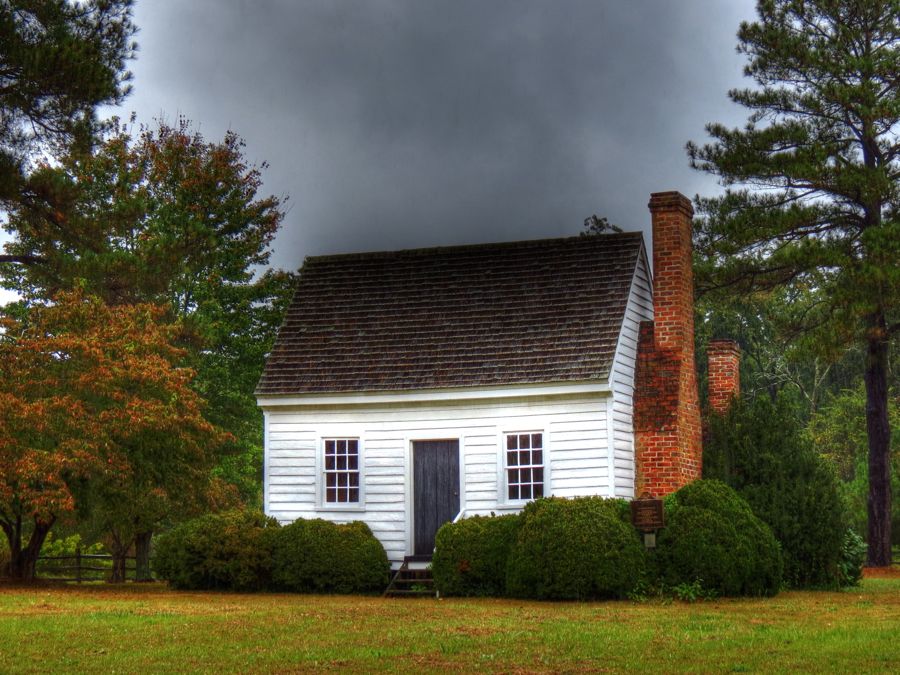 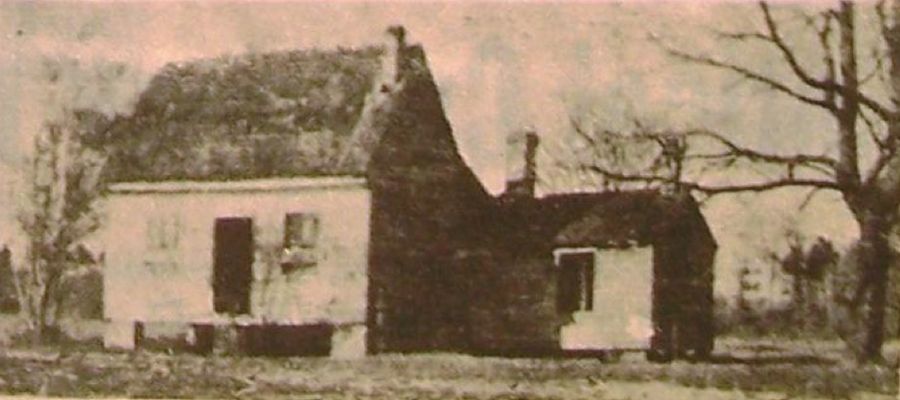   By now, it had occurred to me that the Jamestown Settlement was a national park and, consequently, was not going to be open as a result of the government shutdown. After kicking myself for poor planning a few times, I became determined to see my number-two-most-important destination: the ruins of the Rosewell Plantation. In the early 1700s, Mann Page I was a prosperous farmer and member of the King’s Council in Virginia. In 1725, he decided to build an impressive manor house—one that would be even larger and more luxurious than the Governor’s Mansion at Williamsburg. He succeeded, albeit posthumously. The Rosewell mansion was finished by his son, Mann Page II, in 1737 and was characterized by architectural historian Thomas Waterman as “the largest and finest of American houses of the colonial period.” The drawing on the left shows the mansion’s original Georgian configuration, with a flat roof and two cupolas. The one on the right is much less accurate but shows the two “dependency” buildings that were added later. (The brick walkways connecting the main house and the dependencies were never completed.)   John Page was born at Rosewell and went on to serve as Virginia’s governor in 1802-1805 and a multi-term member of Congress. His friend and university classmate, Thomas Jefferson, was a frequent visitor and wrote the first draft of the Declaration of Independence at Rosewell. Unfortunately, the cost of building Rosewell had nearly decimated the Page family’s fortunes. In 1837, Thomas Booth bought the mansion—and promptly sold off its slate roof, the beautiful marble flooring, mantles, and steps, and nearly all of the mansion’s walnut and mahogany paneling. In fairness, Booth made the house habitable again, but it never regained its former opulence and glory.   Rosewell survived the Civil War, but in 1916 the home was destroyed by fire, leaving only the outside walls standing. Over time, the walls weakened and began collapsing. The ruins were stabilized in the early 1980s, and the Rosewell Foundation was formed in 1995 to preserve the site and open it to the public. On a Thursday, in the pouring rain, I wasn’t all that confident that Rosewell would actually be open, and I wondered whether it might be possible to catch a distant glimpse of the ruins (even if it meant hopping a fence or two). I was pleasantly surprised to find that it was indeed open and that museum manager Beverly was more than willing to brave the elements and unlock the three gates for me! My first sight was of Rosewell’s east wall, which is the most intact.  Although I was anticipating a very large structure, I was overwhelmed by its massiveness. Rosewell had a tall basement and three stories with 13-foot ceilings. Note the four towering chimneys and their imbedded fireplaces (seventeen in all). What a place this must have been.   This sketch shows the original entranceway, complete with its paneling and black-and-white checkerboard marble flooring.  Interior photos of Rosewell are very rare. This one shows the same entranceway, after Thomas Booth’s sell-off.  After taking almost 100 photos of the Rosewell ruins (most of them rain-speckled, despite my attempt to keep the camera under an umbrella), I wandered back to my Z4—which I had uselessly parked under a tree. I wrung as much water as I could out of my jeans’ legs, negotiated the rutted and muddy lane back to the museum, and stopped in to thank Beverly again for her efforts on my behalf. What a place.  Aggh, I can’t help myself: Here is one more story related to Rosewell. Gov. John Page became a widower, and, in 1790 at age 47, he met 30-year-old Margaret Lowther and took her to a dance in his carriage. Afterward, he discovered that she had left a glove behind. He sent it to her with a note that read “Taking ‘G’ from ‘Glove’ leaves ‘Love.’ Tis that I offer thee.” Margaret replied thusly: “Taking ‘P’ from ‘Page’ leaves ‘Age.’ And you are too old for me.” Nonetheless, John and Margaret married a few months later and continued to write poems to each other for the rest of their lives. Okay, next up was a search for “Powhatan’s Chimney,” which was rumored to be only a few miles farther on. Powhatan (or “Wahunsunacock”) was the chief of the Powhatan Indians on the James River in 1607, when the first English settlement was established at Jamestown Island. According to Captain John Smith’s extensive writings, in 1609 he built an English-style house for Powhatan at the Indians’ village of Werowocomoco. That village dated back to 1200 AD and, at the time of Smith’s arrival, was the cultural and political center of about 30 tribes and 25,000 Native Americans making up the Powhatan Confederacy. For many years, historians believed Werowocomoco was centered at the site of this ancient chimney, thought to be from Powhatan’s house:  Subsequent research and archaeological work proved that Werowocomoco was actually about 7 miles farther west. But “Powhatan’s Chimney” lives on. Chief Powhatan is perhaps better known these days as the father of Pocahontas, the Indian maiden to whom Captain Smith owed his life. The classical story in Smith’s journals does not align especially well with the oral history of the Powhatan Indians, but I’m willing to believe it. After all, it’s a great story. Here are John Chapman’s 1839 painting of the Baptism of Pocahontas (the 18 by 12 foot original hangs in the Rotunda of the U.S. Capital) and Victor Nehlig’s 1870 painting of Pocahontas saving Capt. Smith from execution, with Chief Powhatan standing above on a stone ledge. Neither painting is believed to be particularly accurate—for example, Pocahontas was only 11 years old when Smith was captured—but they vividly portray the romance and drama of the traditional stories.   From Powhatan’s Chimney it was only a short drive to Yorktown, where British General Cornwallis surrendered his forces to General George Washington in 1781, precipitating the end of the Revolutionary War.  Yorktown also featured prominently in the Civil War, when General George McClellan’s Union forces captured the city from the Confederates in 1862 and made it a supply base for the balance of the war.  As it happens, Yorktown is also a national park… Fortunately, only the battlefield parking lots were closed as a result of the government shutdown; the rest of Yorktown was wide open, in part because actual people live there. This monument commemorating the 1781 victory was struck by lightning in 1942, destroying the Victory statue at the top. It was replaced with a Liberty statue.  The Customs House, shown here on the left in the historical photo, remains in good shape. It was built in 1721 by Richard Ambler and his son Jacquelin, who were appointed as the first two “Collectors of Port” in Yorktown. Thank goodness the streets were subsequently paved; otherwise all of Yorktown would have washed away before I arrived. 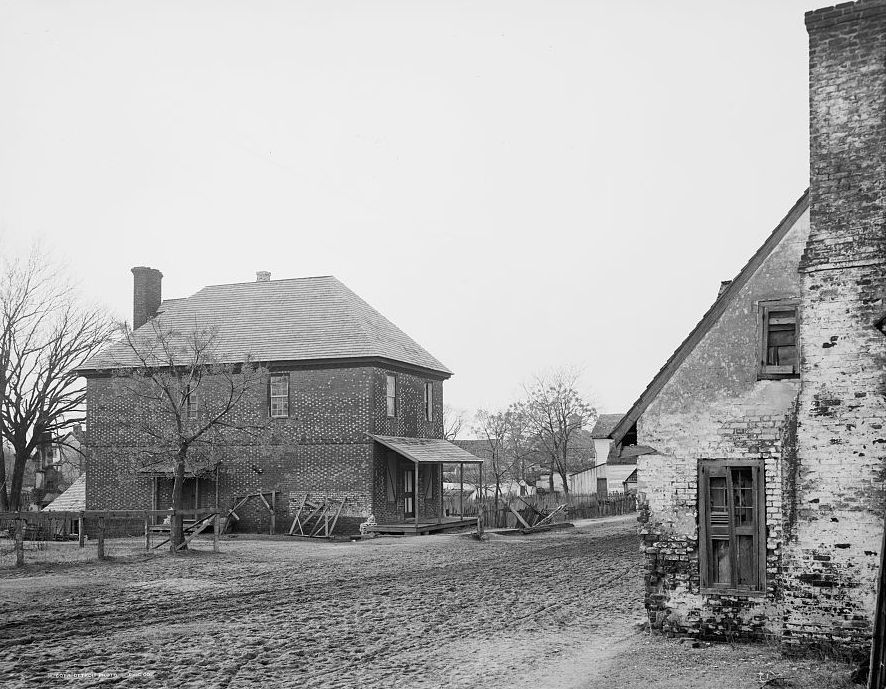  The tall ship Alliance looked historic, but she was actually built in 1995 and offers daysail cruises.  By now it was after 5:00, I was still pretty wet, and it was time to start thinking about dinner and a place to stay overnight. While photographing the 1933 Hornsby House, I spotted a little sign identifying it as a B & B. Definitely the place to stay! But, despite it being a rainy Thursday, they were fully booked. Fortunately, a nearby Mulberry Inn and Red Lobster came to the rescue and all was well.  I awoke the next day determined to see what I could of the Jamestown Settlement, even though it was closed. Our ever-helpful federal government had carefully blocked off the main entrance and all of the parking lots on the island. Consequently, the Z4 would have stood out like a sore thumb while I hiked the couple miles to the settlement. In the end, I made do with this view of Powhatan Creek and Sandy Bay, showing what 24 hours of heavy rain will do the shoreline.  The rain also contributed to this picturesque dripping-berry photo.  Saving the Jamestown Settlement for another visit on another day, I drove west toward the oldest plantation in Virginia. Along the way, I fielded a phone call from my favorite New York Times reporter, who wanted to discuss the trouble-plagued introduction of the “Obamacare” health insurance exchange website. An interesting conversation and one quotation later, I arrived at the Shirley Plantation. 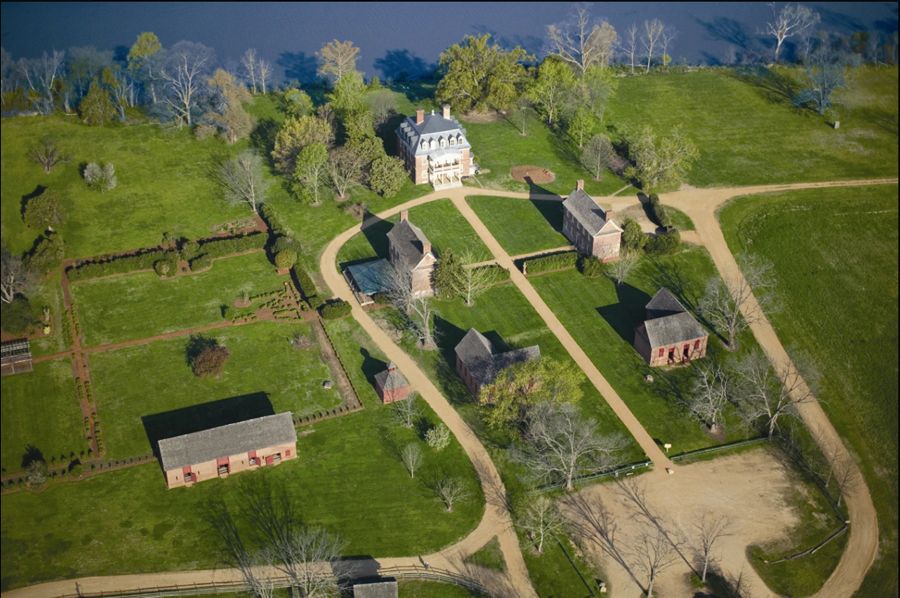 Not unexpectedly, the plantation is reached via a stately, tree-lined boulevard.  Shirley Plantation is arguably the oldest plantation in the U.S., based on the fact that its land was tilled starting in 1614. The present-day mansion was built during 1723-1738. The first owners were the Wests, followed by the Hills in 1638. After several preceding generations, Elizabeth Hill inherited the plantation in 1723 and married John Carter, son of the almost legendary Robert “King” Carter—the wealthiest man in Colonial America. The Carter family has owned and operated the plantation ever since, with the Hills and Carters totaling 11 generations at Shirley. The current Carter family lives in the second and third stories of the mansion, while the first floor is available for tours.  Since it was still raining, I sheltered under the front porch while I waited a few minutes for my tour to begin. I chatted with a delightful young lady who had just been hired as a tour guide and was joining our tour as part of her training. She loves history and was thrilled to have gotten this job while her husband is stationed in Newport News. 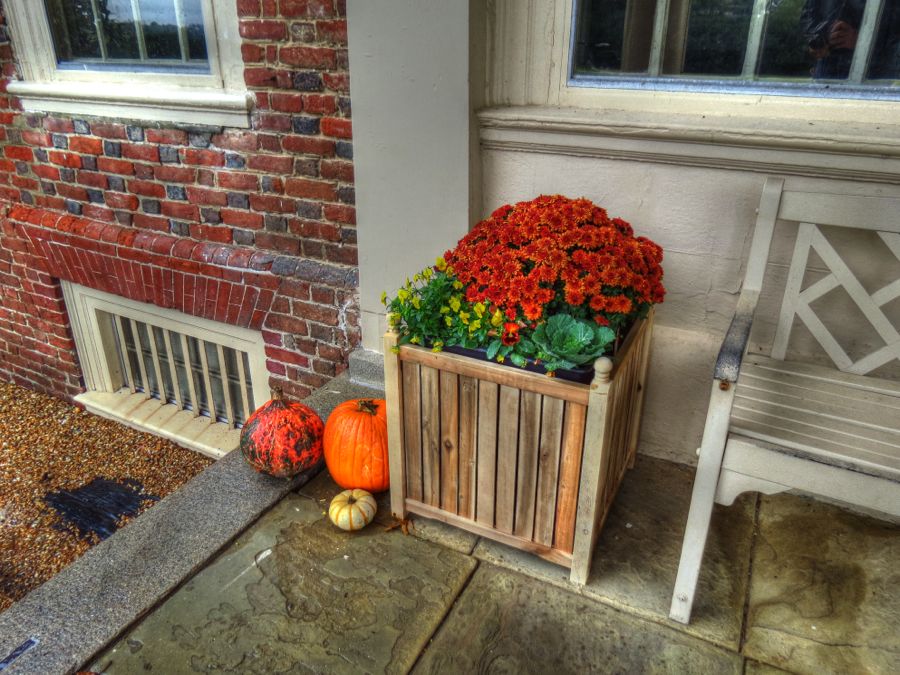  Photos aren’t permitted inside, so I’ve borrowed a couple from the Library of Congress, the Shirley Plantation brochure, the Society of Architectural Historians, and (against all odds) Desperately Seeking Seersucker’s blog. The “flying staircase” in the entrance hall is a tour de force, climbing all three stories with no visible means of support.   All of the rooms contain original Hill and Carter family furniture, along with portraits. In the first photo, Elizabeth Hill Carter is shown above the fireplace in the parlor, with her husband John in the portrait to the left. In 1793, Ann Hill Carter married the Revolutionary War hero and former Virginia Governor Henry “Lighthorse Harry” Lee in this room. Their youngest son, Robert E. Lee, lived here for a time and was a frequent visitor to Shirley Plantation throughout his life. 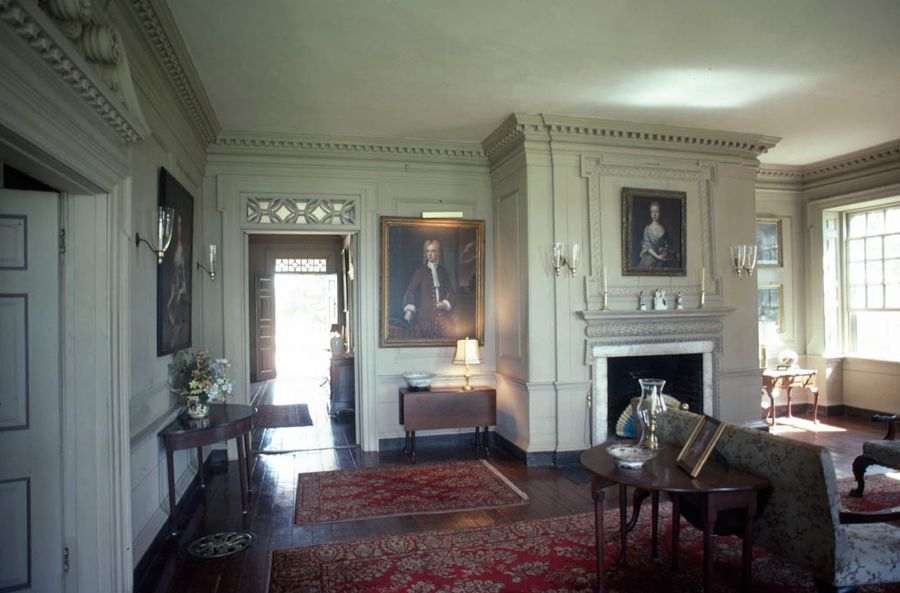   After the tour, I was pleasantly surprised to find that the rain had stopped. (It returned later.) The plantation mansion had once had two adjoining 60 by 24 foot dependencies, much like Rosewell, but these, too, had disappeared over the years. The basement of one of them was retained as a root cellar, offering a view of its vaulted brick ceiling.  This willow oak tree is over 350 years old. It would have been a sapling when the Shirley mansion was under construction.  The plantation’s kitchen was built in 1771 and has survived. “Tuna,” one of the resident plantation cats, is a more recent addition.    Other surviving buildings included the smokehouse and stable pictured here, as well as the storehouse, icehouse, laundry, and the all-importance dovecote (or pigeon house). The corn crib appears to also serve as a hen house and goat assembly area.   Shirley Plantation grew tobacco for many years, until the soil became depleted of nutrients and 20-year-old Hill Carter converted to wheat, corn, and cotton—all of which are still grown. On the day of my visit, the cotton was a bit soggy.   During the Civil War, a substantial number of Virginia’s plantations were plundered and destroyed by Union troops. With Hill Carter and his six sons all off to war in the Confederate Army, daughter-in-law Louise Humphreys Carter and four other female relatives were left to face Gen. George McClellan’s Union Army on her own when they arrived at Shirley in July 1862 following the Battle of Malvern Hill. The troops used the Shirley Plantation lands as a field hospital for the thousands of wounded soldiers, and Louise and her mother- and sisters-in-law helped tend the men. As Louise wrote in her journal, “Mama had to tear up sheets and pillow cases to bind up their wounds and we made them soup and bread every day until they died or were carried away.” Many, in fact, had to be left at Shirley when the army retreated. In recognition of the Carters’ care, Gen. McClellan issued a “proclimation of safeguard” for Shirley Plantation, which was honored throughout the remainder of the war.  When mother-in-law Mary Braxton Carter died in 1864, Union officers advised the family not to bury her in sight of the Union gunboats patrolling the James River, for fear that they would be fired upon. They decided to bury her at night, in the family plot immediately next to the river—but the “servants” were superstitutious and would not go into the cemetery after dark. Once again, Louise came to the rescue, burying her mother-in-law herself. Speaking of “servants”… Many plantation owners and their families became quite wealthy, and virtually all of them did so in substantial part because of slave labor. Initially, the Shirley Plantation used only white indentured servants, but by 1783 over 190 African slaves were forced to work there. In 1787, Charles Carter owned a total of 785 slaves across his various properties, making him the largest slave owner in Virginia. Charles’ son Robert inherited Shirley Plantation, but he abhorred the concept and practice of slavery. Sadly, rather than freeing Shirley’s slaves, he instead chose to leave the plantation and become a doctor. Slavery continued until after the Civil War, at which time many of the former slaves became tenant farmers at the plantation.  Reflecting on history’s sorrowful side, I stopped at another plantation’s cemetery. We are getting better, aren’t we? Even if only gradually, and with many reverses? We can only hope so.  I found St. Peter’s Church, which, by an act of the Virginia Assembly, is known as “The First Church of the First First-Lady.” It was built in 1703 by Colonel Joseph Foster (more on him in a moment), and replaced an earlier 1685 church that, due to its deteriorating condition, had become known as the “Broken Back’d Church.” The striking two-story tower was added in 1740. As a girl, Martha Dandridge attended services here and in 1749 married Col. Daniel Parke Custis. Ten years later and now widowed, she married again—this time to Col. George Washington. Their marriage probably took place in this church, but historians are not certain.  St. Peter’s was another Anglican church that was abandoned following the American Revolution. It was rescued by Presbyterians and later became Episcopalian. The church also fared poorly during the Civil War. Union forces used the sanctuary as a stable for their horses, carved their initials in the bricks, and generally behaved like frat boys. After the war, Robert E. Lee, his wife Mary Ann Randolph Custis Lee (Martha’s great-granddaughter), and their son William Henry Fitzhugh Lee (whew…) took up the cause of the church and helped restore it.   Now, back to Col. Joseph Foster. As many of you know, my last name is Foster, so when I read about Foster’s Castle, I was determined to get a look at it. As I drove the long-suffering Z4 up the nearly mile-long dirt driveway, I practiced several possible explanations for my abrupt intrusion: “Hi, my name is Rick Foster and I want my house back!” Or, “Hi, I was thinking that the next Foster Family reunion should be held here!” You get the idea. Anyway, I reached the end of the driveway, found Foster’s Castle, found no one around, took a couple of photos, and beat a hasty retreat. (Despite 15 minutes of hard, online research, I was unable to determine whether I’m related to Col. Joseph.)  Foster’s Castle was built in 1687, originally as a one and a half story fortified home with a two-story front tower. It was modified to a full two stories in 1873, and it’s fairly easy to spot the original, whitewashed bricks versus the later dark red ones. The windows have also been modified somewhat. The Gregory family has owned the home ever since 1872, and they even had the nerve to shorten its name to just “The Castle.” Hmmph!  The Civil War touched just about every part of Virginia, and Foster’s Castle was no exception. This photo of Union troops encamped alongside the Pamunkey River was taken near the historic home. 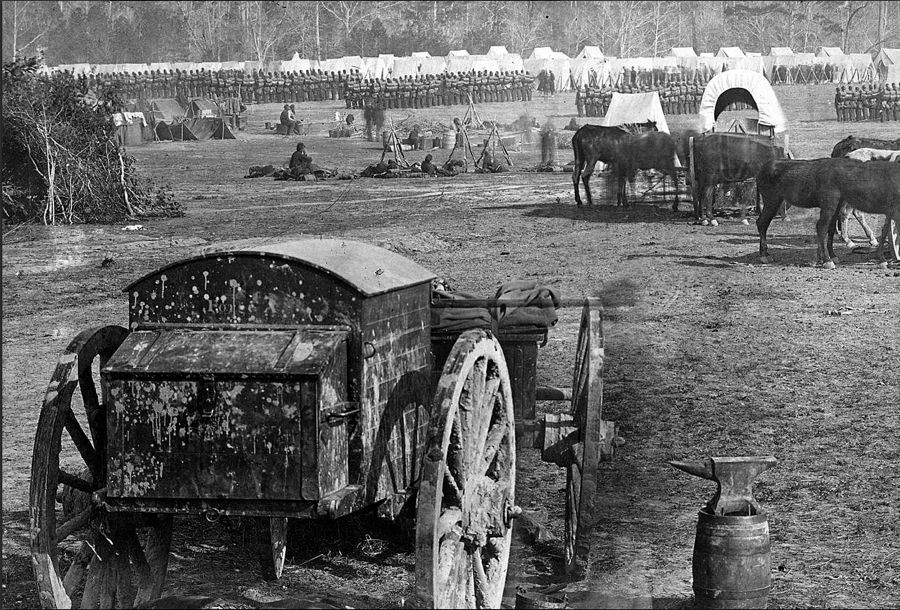 As often happens on my trips, I left my planned route to investigate another Baptist church for Cathy and Kim. A 5-mile roundtrip later, it turned out not to be very interesting. But coming back down the mountain, I spotted the top of an old-looking building among some trees. It, too, wasn’t interesting. But as I walked along these railroad tracks, way in the distance was what looked like a station…  Sure enough, I’d found an old railroad station from about 1860. It had apparently been converted to Lipscomb’s General Store sometime along the way. The station’s siding was clearly no longer in use, but the main tracks were nice and shiny. Contrary to Satchel Paige’s exhortation “Don’t look back; something might be gaining on you,” I kept eyes and ears peeled for possible approaching trains. (Another of his maxims was “Avoid fried meats, which angry up the blood.” It didn’t seem to fit my situation as well.)  Back home, another 15 minutes of in-depth historical research on the Internet enabled me to identify this site as Tunstall’s Station on the Richmond and York River Railroad. In 1862, as Col. J.E.B. Stuart’s cavalry was performing their famous 3-day, 150-mile ride completely around Gen. George McClellan’s Union Army, they stopped here to cut the telegraph wires, toss a tree onto the tracks, burn some supply wagons, and generally behave like frat boys. In the midst of their merriment, they heard a Union train approaching and promptly set up an ambush. The train proved to be carrying troops, and, as it slowed, the Confederates opened fire. The engineer shoved the throttle back open, and the train passed through the melee—but the engineer died almost instantly, along with several of the Union soldiers.  J.E.B. Stuart’s ride around McClellan’s forces sealed his reputation for daringness and adventurous tactics. The reputation of Union Cavalry Gen. Phillip St. George Cooke, who had been charged with finding Stuart’s cavalry and defeating them, was ruined; he never served in the field again. On top of all that, Gen. Cooke was Stuart’s father-in-law… His daughter, Flora Cooke Stuart, apparently sided with her husband and the Confederate cause; the Stuarts’ oldest son had been named after Gen. Cooke, but following the outbreak of the war, they renamed him J.E.B. Stuart, Jr. After Stuart’s death at the Battle of Yellow Tavern in 1864, Flora never remarried and wore black mourning clothes for the remaining 59 years of her life.    Once again, a nearly random deviation from my route resulted in discovering a fascinating piece of history. The Immanuel Episcopal Church wasn’t in my planned route either, but its stately Gothic Revival design necessitated a stop. It was built in 1853 and modified several times over the years, including the addition of Gothic elements in 1881. Leaving the churchyard, I got my directions confused and managed to retrace roughly 8 miles of my route in the wrong direction—which is a new record for me—before realizing the “error of my way.” My mistake finally dawned on me after seeing a lane named “Devil’s Three Jump” twice in one afternoon…  It’s pretty common to come across a murder of crows in a cornfield—but this time they turned out to be vultures! They paid no attention to me, which was surprising (but a good thing all the same).  I was next looking for what I thought were the ruins of St. Matthews Church near the Rappahannock River, but all I could find was a church-like Old Church Store. Baffled, I snapped this photo and continued on, only to learn later that this was St. Matthews Church. It became a general store some years ago. Yes, there is no doubt about it: You’re traveling with a moron!  Layton Landing sounded like it would offer a good view of the Rappahannock River, so I detoured there but found only a small development with no place to get to the water. I had a good time sliding the Z4 around on the muddy dirt lanes, but I was long overdue back home and needed to press on. Returning to Route 17, however, I spotted what looked like a perfect abandoned house far off in a field. I managed to find this entrance to the property, but the path ahead was hopelessly rutted, so I parked here.  The house was a good quarter mile or more across these soaked fields. Umbrella in one hand, camera in the other, Yr Intrpd Rprtr ventured forth.  Eventually I reached the house and was relieved not to hear any barking, chainsaws starting, or any other Indications o’ Trouble. The first photo below shows the front of the house, I think, based on the more ornate entrance porch and door. The back was equally scenic in a rustic and deteriorating way.   Have you ever imagined, as I constantly do, that every abandoned house is filled with rare antique furniture, priceless artifacts, the odd detritus of a long-gone everyday life, or maybe even a treasure chest full of gold and jewels? (Okay, so I have an active imagination.) Well, the inside of this place, as seen through a couple of broken windows, didn’t quite live up to my hopes.   As my trip was nearing its end, I tried fruitlessly to reach Port Micou, an 18th-century landing on the Rappahannock for transporting tobacco. In the process, I inadvertently ended up on two out of three families’ personal property—with Port Micou, naturally being on the third one. There were scenic sights along the way, fortunately, including a flock of wild turkeys. Unlike their vulture cousins, these guys were smart enough to flee from possible danger.    Vauter’s Church was built in 1719 and expanded in 1731. Remarkably, the church was not damaged in the American Revolution, War of 1812, or Civil War. It’s been renovated several times; in the most recent example, the original wooden roof shingles were replaced with concrete lookalikes. The Vauter Family continues to have reunions at the church, even after almost 300 years.  In the 1827 remodeling (when the church resumed services, following its abandonment in 1776), the box pews were reduced in height and the original three-level pulpit was changed to the two-level one shown here. (Photo courtesy of Virginia Travis on Flickr.) 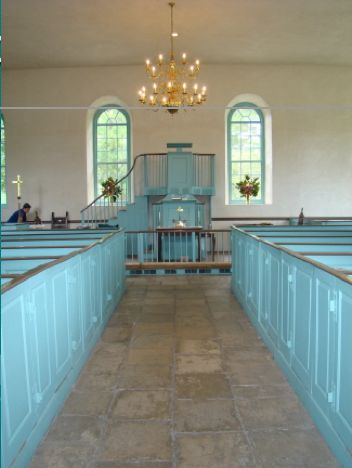 I was now on a mad dash through the rain to get back home—but, of course, I had to detour through historic Port Royal, just for old times sake and more old times sake. This was the home approached by John Wilkes Booth and David Herold during their escape from Washington, DC, where Booth had assassinated President Lincoln 10 days earlier. They were allowed into the parlor (below), but when they asked to spend the night here, Sarah Jane Peyton politely refused, since her brother was away and it would be improper for strange men to stay the night without the man of the house present. She helpfully suggested that they try Garrett’s Farm, 2 miles south of Port Royal. They did, and were found there by Union troops not long after, with Booth shot and killed while resisting capture.  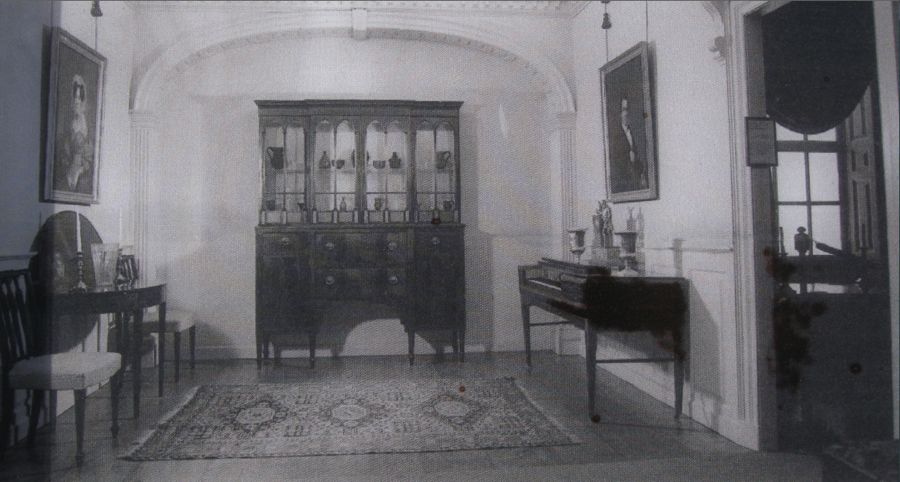 I also wanted to get a quick look at the Belle Grove Plantation mansion, just on the other side of the Rappahannock. The mansion proved to be a stunning sight. It was built in 1790, replacing an earlier one from 1751—which had been the birthplace of James Madison, Jr., the fourth U.S. President and “Father of the Constitution.” The older home no longer exists, but the current one more than makes up for its loss.  This 1894 image is the earliest known photograph of Belle Grove. The color photo is from 1940.   Belle Grove deteriorated badly between 1971 and 1987 but was purchased and thoroughly renovated by the Haas family of Vienna, Austria. Today, Belle Grove is a beautiful bed and breakfast—one that I would like to stay in sometime soon! I dodged the Friday rush hour traffic around Washington, DC by crossing the Potomac on Route 301, and I finally made it home safe and sound. Both the Z4 and I were thoroughly soaked again, but it was a terrific journey and neither one of us was complaining. Best of all, I have a good excuse to go back for additional exploration, now that the Jamestown Settlement and other national parks have reopened! Rick F. |
| 11-01-2013, 10:41 PM | #4 |
|
Iron Ring

11
Rep 316
Posts |
Wow. I learned so Much! Thank you. Glad you were spared Hydro lock.
We have had 2 bmws with code air injection added by other owners. Low, behind the bumper... well done Sir! edit....code? code? COLD!  Last edited by DaveL--2mnycars; 11-02-2013 at 02:38 PM.. Reason: spellcheck |
|
Appreciate
0
|
| 11-02-2013, 09:05 PM | #6 |
|
Down Under!!

1621
Rep 4,294
Posts |
Mate, I always love your submissions.. Same holds true for this one. Thanks for putting in the time to try and educate some of us. Lovely drive mate, just awesome. By the way, can u stick up some specs of your camera (missus wants to know) and some of your settings, that pic of your zed in that overgrown driveway is a must for picture of the month sub.
Very nice trip. Once again, I thank you.
__________________
2007 EuroSpec Z4///MC - Building/Developing Z4 GT3
Powered by  |
|
Appreciate
0
|
| 11-03-2013, 11:14 PM | #7 |
|
First Lieutenant
  7
Rep 376
Posts |
Another wonderful story Rick. Your beautiful pictures along with their historical counterparts is so amazing. And what a great style of writing with a sense of humor that makes it easy for anyone young or old to enjoy. I have read so many of your adventures that it makes me wonder how many miles you have on your Z4? It also wobbles my mind the things that you put it through. Talk about the little Z that could!!
__________________
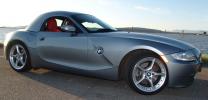 |
|
Appreciate
0
|
| 11-04-2013, 08:31 AM | #8 |
|
Lieutenant
   
9
Rep 452
Posts |
Nicely done, Rick. Please keep them coming, we savor every one!
__________________
Vibra Technics engine mounts / Rogue trans mounts / Stoptech brakes / original owner
|
|
Appreciate
0
|
| 11-05-2013, 08:51 PM | #10 | |
|
Lieutenant Colonel
 948
Rep 1,910
Posts |
Quote:
Great, I'm very glad that you enjoyed the tour! In addition, I'm curious as to the source of your "demise" quotation. It sounds like something I should recognize, but I don't. Please educate me! Rick |
|
|
Appreciate
0
|
| 11-05-2013, 08:56 PM | #11 |
|
Lieutenant Colonel
 948
Rep 1,910
Posts |
itdnwiwbp,
It was definitely a fun trip, despite the rain and national park closures. In fact, the rain added a certain positive element to the experience. After I'd splashed through the muddy lane to the Rosewell ruins, parked the car, and walked in the pouring rain to the site, I was even more awestruck by the size of the place, its isolation, and its having weathered so many prior storms over all these years. Next time, however, I'll take a second pair of jeans with me! Rick |
|
Appreciate
0
|
| 11-05-2013, 08:59 PM | #12 | |
|
Lieutenant Colonel
 948
Rep 1,910
Posts |
Quote:
My pleasure, sir! And thanks for the clarification on the "code air injection," which had baffled me. You wouldn't think that an engine would generate enough intake vacuum to pull in something as heavy as water--but they can and they do. I've heard of several 944 owners who encountered this very expensive problem, and a few motorcycle owners, too. Rick |
|
|
Appreciate
0
|
| 11-05-2013, 09:00 PM | #13 |
|
Lieutenant Colonel
 948
Rep 1,910
Posts |
|
|
Appreciate
0
|
| 11-05-2013, 09:11 PM | #14 | |
|
Lieutenant Colonel
 948
Rep 1,910
Posts |
Quote:
Hey, I'm glad to hear that you enjoyed the write-up. I certainly enjoyed putting it together. I'm using a Canon SX40 HS "super zoom" digital camera. Almost all of my photos are taken using aperture priority, with the F-stop set to match the light and to maintain a shutter speed in the 1/100th to 1/200th range. Since I take 3 exposures for each photo, at - 2, 0, and +2 stops, the resulting range of shutter speeds will still be fairly optimal. On occasion I'll purposely use a narrow aperture like F8 to maximize the depth of field. F8 is the maximum setting on this model Canon; a higher option would be useful on occasion. If the light is limited, then I'll try to set the camera on something solid, like a fence post or rock. If I'm desperate, I'll break out the tripod, but that's generally too time-consuming. The great majority of m shots are hand-held. I also use the "vivid" color setting, since I like the colors to pop a bit. Also, to my eye, this setting better matches reality than the somewhat dull non-vivid option. Finally, I use hdrsoft's Photomatix Pro software to combine and process the 3 exposures into a single composition. Check out hdrsoft.com's tutorials for using high dynamic range (HDR) photography to optimize the details in both the darker and lighter areas of a photo. It's almost magical! Thanks for the suggestion regarding the picture of the month--I'll give it a try. Rick |
|
|
Appreciate
0
|
| 11-05-2013, 09:22 PM | #15 | |
|
Lieutenant Colonel
 948
Rep 1,910
Posts |
Quote:
Thanks! As for my long-suffering Z, yes, it certainly has tackled some remarkably unsuitable terrain over the years. However, I have yet to bury it up to its axles in mud, as I once did with my 1981 BMW 320i. (It was night, and I had no idea that the mud was that deep!) My car has about 47,000 miles on it now. I bought it as a CPO from Tischer BMW-Porsche-Audi in the June 2009, with 23,000 miles on it. I have an Acura TL for daily driving, family vacations and trips, and so forth, so the Z gets used almost exclusively for touring. Although my car is "just" a 3.0i, it really meets my needs very nicely. It has the sport package, so it handles very well and the seats are great. And 215 hp is fine for my purposes. (I ran a Spec Racer and later an ITS Datsun 240Z in SCCA racing for 10 years, so I've largely met my inner high-performance driving needs.) However, I do wish the car had a little more leg room. On longer highway trips to get to a tour destination, my old knees start aching a bit! Rick |
|
|
Appreciate
0
|
| 11-05-2013, 09:24 PM | #16 | |
|
Lieutenant Colonel
 948
Rep 1,910
Posts |
Quote:
Thanks! I'm just now starting to think about my next tour, so I'll definitely keep the stories coming. It's just so much fun to get out there, driving a colossally excellent car and discovering history and scenery around every corner. It's actually pretty addictive! Rick |
|
|
Appreciate
0
|
| 11-05-2013, 09:30 PM | #17 |
|
Lieutenant Colonel
 948
Rep 1,910
Posts |
RB,
Thanks! Photography has come a long way since my college days, when I had my Dad's hand-me-down, pre-war Kodak rangefinder camera (with an occasionally sticking shutter), and when I couldn't afford more than 1 roll of film a month! For that matter, I couldn't afford a car back then, either, let alone a BMW. But I got around okay on a $300 Yamaha 180. As for my enjoyment of writing, I have my grandmother to thank for that. She taught English in high school and college--which was quite an achievement for a woman born in the 1880s! Anyway, that's a long-winded way of saying that I enjoy taking the photos and writing up the results, and I'm very pleased that you and others like reading them. Rick |
|
Appreciate
0
|
| 11-06-2013, 08:25 AM | #18 | |
|
Major
 79
Rep 1,443
Posts |
Quote:
__________________
 |
|
|
Appreciate
0
|
| 11-08-2013, 12:00 PM | #19 | |
|
Lieutenant Colonel
 948
Rep 1,910
Posts |
Quote:
I can't wait, either--and that's hysterical about your father working at Jamestown! My father and I once visited his alma mater, Grinnell College in Iowa. A highlight of the visit was when we went to the college bakery, which was one of a number of places where he worked to put himself through school. When the bakery ladies learned that he used to work there, they insisted that we try each of the goods they were baking that day! We also found where he used to wash dishes for the cafeteria. It's still the dishwashing area--but now they have a huge automated machine, instead of a dozen struggling students. Anyplace else around Jamestown that I should add to the touring list? Rick |
|
|
Appreciate
0
|
| 11-16-2013, 01:55 PM | #20 |
|
Major
 79
Rep 1,443
Posts |
I haven't been to Jamestown in at least a decade but I'll ask my dad for a list of highlights. I'm sure he'll have some suggestions as he knows the area quite well. During his time at W&M he also wrote the material for many of the tours at Colonial Williamsburg and Jamestown.
The story he always tells about working at Jamestown was the time he was giving a tour to a group that included a couple families with small children. At one point during the tour while he was explaining something he looked down to find a small child petting his fur loincloth. Of course he was horrified and I don't recall the aftermath but at least my dad didn't end up on any child predator lists and Dateline hasn't tried to entrap him yet.
__________________
 |
|
Appreciate
0
|
| 11-17-2013, 10:52 PM | #22 | |
|
Lieutenant Colonel
 948
Rep 1,910
Posts |
Quote:
Thanks much! I enjoy the trips and writing them up. Ironically, for ever hour I spend touring in the Z4, I probably spend 2 hours researching what it was that I saw during the trip. It's addictive but also a lot of fun, especially when you track down something really interesting about a seemingly insignificant place. As for a book, it's definitely on my list of things to do, but it probably won't happen anytime soon. But you never know… Rick |
|
|
Appreciate
0
|
Post Reply |
| Bookmarks |
|
|